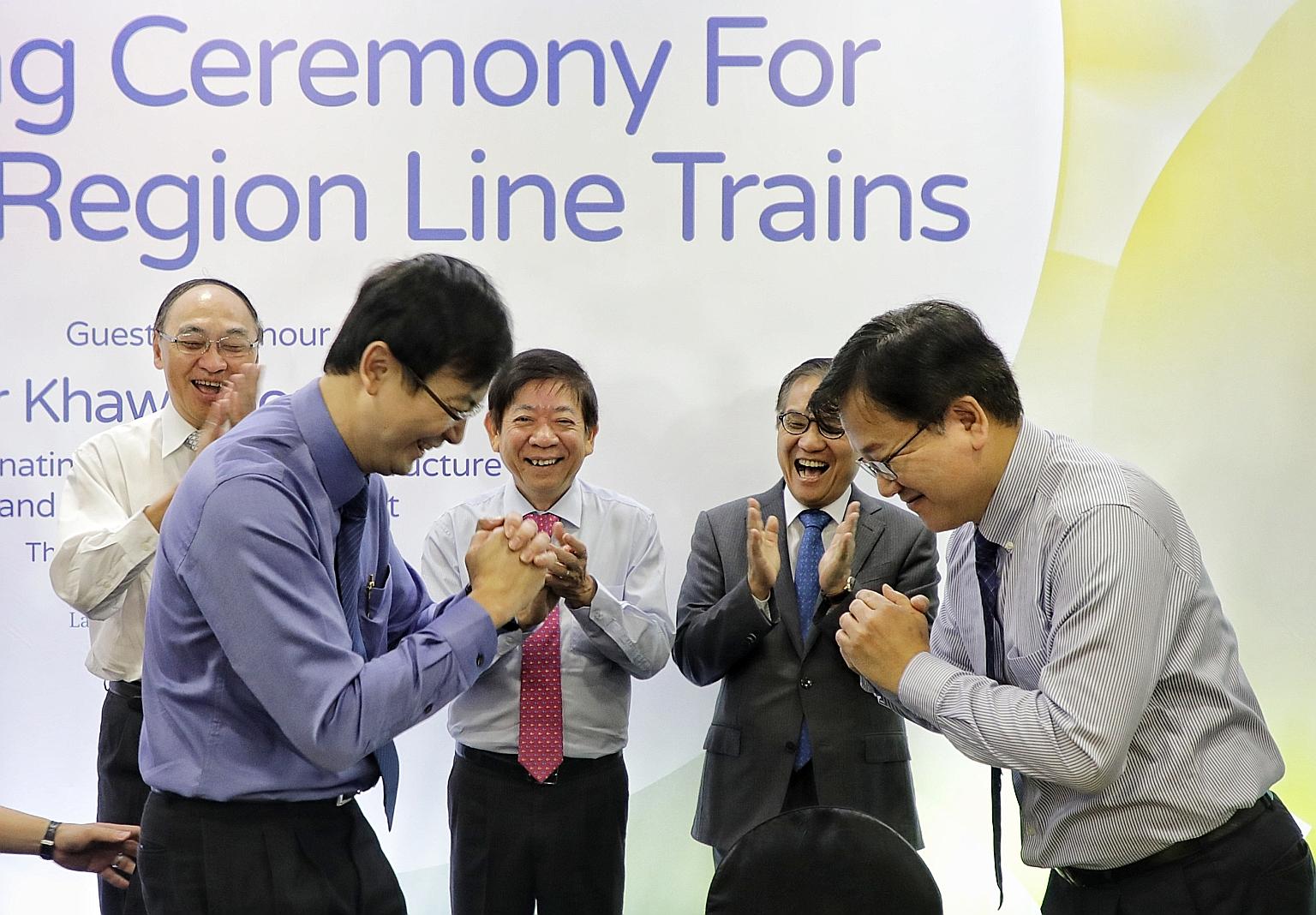Emergency batteries for MRT trains on future line
This means trains on Jurong Region Line can travel to nearest station during power failure
Sign up now: Get ST's newsletters delivered to your inbox

Mr Ngien Hoon Ping (in blue), LTA chief executive, and Mr Choi Dong-hyun, vice-president and chief operating officer of railway business division at Hyundai Rotem, congratulating each other after the signing ceremony. Looking on are (from left) LTA chairman Alan Chan, Transport Minister Khaw Boon Wan and South Korean Ambassador to Singapore Ahn Young-jip.
PHOTO: LIANHE ZAOBAO
Christopher Tan Senior Correspondent, Christopher Tan
Follow topic:
Trains for the Jurong Region Line (JRL), slated to be operational from 2026, will have emergency batteries which allow them to be driven to the nearest station should there be a power failure.
They will be the first trains to have such a feature. Today, passengers on a stranded train will have to disembark and walk along the tracks to the nearest station if a rescue locomotive cannot get to them.
Transport Minister Khaw Boon Wan announced this yesterday at a signing ceremony for the train supply contract, held at the Land Transport Authority (LTA) headquarters.
The $416.5 million deal went to Hyundai Rotem, an established South Korean group which has clinched its maiden train supply contract here.
It will supply 62 three-car driverless trains for the JRL, a medium-load elevated rail line with stations that can accommodate four-car trains serving places such as the Jurong Lake District, the Jurong Innovation District and Nanyang Technological University (NTU).
Trains for the 24km, 24-station system will be smaller, to accommodate the tighter turns in the pi-shaped line. Each car has a capacity of around 150 passengers, versus over 200 for trains on lines such as the North-South and East-West lines.
Like all new trains slated for Singapore's network, the JRL trains will have condition-monitoring systems to detect faults in real time, allowing the yet-to-be-appointed operator to do predictive maintenance.
They will also have wider doors for speedier access.
Mr Khaw said Hyundai Rotem "has committed to establish a base in Singapore, to facilitate knowledge transfer and technical support to the JRL operator", allowing it to provide long-term service support.
The company has supplied trains to metros in cities such as Seoul, Hong Kong and Vancouver. It had also worked on the midlife refurbishment of Singapore's first-generation trains for the North-South and East-West lines.
Mr Khaw said the JRL will further enhance rail connectivity in the north-west. "More direct journeys from north to west will become possible," he said. "For instance, if you are a PSA worker living in Choa Chu Kang West, you can halve your journey time to Tuas Link station to around 30 minutes.
"An NTU student from Boon Lay MRT station will similarly halve his journey time to around 15 minutes."
Mr Khaw also revealed that all existing MRT lines here have crossed the one-million MKBF mark. MKBF stands for mean kilometres before failure, and is a widely used measure of reliability.
As at the third quarter of last year, the Downtown and Circle lines clocked just over 900,000 MKBF, while the others - the North-South, East-West and North East lines - exceeded one million. By end-2019, all had crossed the million mark. Overall, the MRT network clocked 1.32 million MKBF by last December.
There were four major MRT disruptions last year and 11 on the LRT. This compared with nine and 11 respectively in 2018.
"This is a standard that few metros have achieved," Mr Khaw noted. "I would like to thank all our rail workers and LTA officers for this significant achievement."
The reliability standard is several times that of the 58,000 MKBF clocked in 2011, and has arrived after a multi-year, multibillion-dollar effort to renew the system.
Last month, Mr Khaw revealed that renewal of the North-South and East-West lines would cost more than $2.5 billion when it is completed by 2024.
Yesterday, he also took the opportunity to remind transport workers to "protect themselves, as well as protect commuters" during the coronavirus outbreak.

